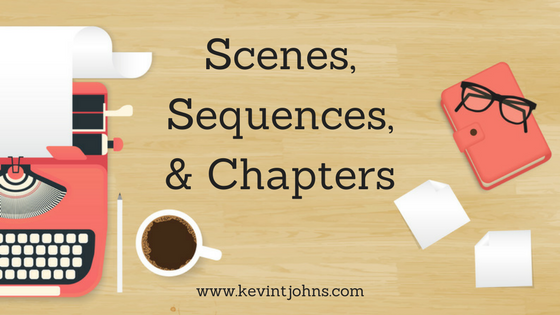Authors, editors, and writing coaches like myself have a number of different terms we use to group together story moments and beats within a narrative. There are so many terms, in fact, that writers and aspiring authors can sometimes get confused about the difference between terms like “scenes”, “sequences”, and “chapters”.
As such, in this article we’re going to look at the difference between these three key concepts. By the end of this article, you’ll understand not only the difference between scenes, sequences, and chapters, but also how they work together to create a cohesive and engaging narrative within your book.
We’ll start with the all-important story unit known as the SCENE.
Scene
A scene is one continuous piece of action within a linear timeframe and generally contained to a single location. A leap forward in narrative time, or a change in setting/location, usually marks the end of one scene and the beginning of a new one. We call this a scene-break.
When a scene-break happens within a chapter, it is usually identified by three centered asterisks or a double spaced brake between paragraphs. These techniques are meant to serve as a subtle visual signal to the reader that the scene they were reading has ended, and that when the story picks up again it will be taking place “elsewhere” or “later that day”.
Shawn Coyne (The Story Grid: What Good Editors Know) and Robert McKee (Story: Style, Structure, and the Principles of Screenwriting) are both in agreement that an effective scene must contain a polarity shift, i.e. things need to go from good to bad, or from bad to good. If there isn’t a major shift in polarity, nothing has really happened in your scene, which means it’s time to go back to the drawing board.
For more information on how to write a great scene, check out The Five Commandments of Storytelling.
Now that we have clarity around a scene, let’s turn our attention to the term SEQUENCE.
Sequence
A sequence is a collection of scenes that are connected or related in some significant manner, either dramatically, narratively, or thematically. A novel will be made up of many sequences, just like a sequence is made up of several scenes.
The “triptych approach” to developing a sequence, for example, includes a scene that is primarily set-up, followed by a scene that contains the main action or conflict, and then a scene that focuses on the response to that action or conflict. These three scenes work together to form a short sequence.
A sequence does not, however, have to be limited to just three scenes. A “date sequence” in a romance novel might include several of scenes, such as:
- Getting dressed for the date.
- The dinner portion of the date.
- A walk in the park after dinner.
- The kiss good night on the apartment steps.
These four scenes (note that each takes place in a different location and time) work together to form our “date sequence”.
While each scene should contain a turning point where the polarity shifts, McKee suggests sequences should also contain a larger polarity shift. In this “date sequence” example, perhaps our character began the sequence feeling pessimistic about the date, and by the end of the sequence found themselves falling in love. The four scenes thus work together to create this larger polarity shift over the course of the sequence.
While what makes up a scene is fairly specific (continual time and space), a sequence is a little more vague in that the connections between these scenes aren’t as explicit.
Now what makes chapters unique from scenes and sequences is that a chapter break can happen at any time.
Chapter
A CHAPTER is a tool authors use to force their readers to take a breath, ensuring a momentary pause in the narrative. This is accomplished by forcing the reader to make the deliberate action of turning the page.
In book production, the spread of two pages within a book is identified as consisting of the recto page (right hand page) and the verso page (left hand side). As per book publishing conventions, a new chapter always begins on the recto page. This means when a chapter ends, the reader must take a break by either turning the recto page over and skipping the blank verso on its back, or, if the chapter ends on the verso, by having some blank space at the bottom of the reading page, and usually at the top of the new chapter page.
A chapter break, then, is a dramatic tool you can keep in your storytelling arsenal.
If you are so inclined, you can break up a single scene with a chapter: you can have two characters talking in a single location, end the chapter at a dramatic point in the conversation, and then pick up the conversation at exit same moment immediately at the beginning of the next chapter. The single scene is continued across two chapters, with the chapter break serving as a dramatic pause.
When it comes to chapter length, there is no right answer. Shawn Coyne recommends 2000 word chapters, which he describes as “potato chip length”. But whether to go short, medium, or long length with your chapters depends on your preference as an author and on the demands of the story you are telling.
Some authors prefer longer chapters containing multiples scenes and sequences, while others prefer each chapter to contain just a single scene.
J.K. Rowling’s Harry Potter and the Half-Blood Prince and Dan Brown’s The Da Vinci Code are comparable in length at around 150K words long each, but The Half-Blood Prince contains only 30 chapters, while The Da Vinci Code contains 106 chapters.
Why the difference?
Longer chapters often feel more immersive to the reader. This can be great for fantasy (like Half-Blood Prince) or science fiction stories where, as an author, you need to draw the reader into a new and fantastic world. Shorter chapters, on the other hand, give a fast-paced feel to the story and are great for creating cliff-hangers at the end of chapters. This can be especially effective for thriller (like Da Vinci Code) and action stories.
In the past, chapters tended to be longer. These days, modern authors tend to err more on shorter end of things. Ultimately, chapter length is a stylistic and dramatic decision you’ll need to make for yourself.
Regardless of whether you chose to go with longer or shorter chapters, you’ll want to ensure a certain measure of consistency in chapter-length throughout your book. If you have five chapters all 1000 words in length, and then suddenly drop an 8000 word chapter on the reader, it’ll likely be jarring and impact the flow of the reading experience in a negative manner.
For some other examples of how chapters can be used for stylistic purposes, look to Irvin Welsh’s Trainspotting, where chapter breaks serve as an opportunity to change narrators, each of whom have a vastly difference point of view and voice, or to Twilight: Breaking Dawn, where a series of chapters with no words at all serves to emphasis the protagonist’s prolonged feeling of emptiness and the passing time.
Our Three Terms Revisited
To revisit our three terms:
Scenes are a continuous piece of action contained to a set time and location.
Several scenes with a connected narrative thread work together to form a sequence.
Chapters are a stylistic tool authors use primarily to create a momentary dramatic break in the narrative.
Enjoy this Article? Get My FREE 4-Part Online Course for Authors
Discover the author mindset sucess formula today. Insert your name and email below for instant access.
I value your privacy and would never spam you







